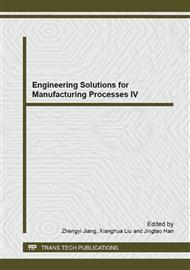[1]
F. C. Schweppe, Sensor array data processing for multiple signal sources, IEEE Trans. On Inform. Theory Vol. 14, No. 3, pp.294-305, (1968).
DOI: 10.1109/tit.1968.1054121
Google Scholar
[2]
R. O. Schmidt, Multiple emitter location and signal parameter estimation, IEEE Trans., on Antennas Propagat., Vol. 34, No. 3, pp.276-280, (1986).
DOI: 10.1109/tap.1986.1143830
Google Scholar
[3]
S. S. Reddi, Multiple source location- A digital approach, IEEE Trans. Aerosp. Electron. Syst., vol. AES-15, pp.95-105, (1979).
DOI: 10.1109/taes.1979.308800
Google Scholar
[4]
R. Kumaresan and D. W. Tufts, Estimating the angles of arrival of multiple plane waves, IEEE Trans. Aerosp. Electron. Syst., vol. AES-19, pp.134-139, (1983).
DOI: 10.1109/taes.1983.309427
Google Scholar
[5]
L. C. Godara, application of Antenna Array to mobile Communications, Part II: Beam-Forming and Direction-of-Arrivial Considerations, Proc. IEEE, vol. 85, pp.1195-1245, (1997).
DOI: 10.1109/5.622504
Google Scholar
[6]
I. Ziskind and M. Wax, Maximum likelihood localization of multiple sources by alternating projection, IEEE Trans. on Acoust., Speech, Signal Processing, Vol. 36, No. 10, pp.1553-1560, (1988).
DOI: 10.1109/29.7543
Google Scholar
[7]
K. Sharman, Maximum Likelihood estimation by simulated annealing", Proc., ICASSP, 88, New York, pp.2741-2744, (1988).
Google Scholar
[8]
P. Stoica and A. B. Gershaman, Maximum-Likelihood DOA Estimation by Data-Supported Grid Search, IEEE Signal Processing Letters, Vol. 6, pp.273-275, (1999).
DOI: 10.1109/97.789608
Google Scholar
[9]
P. Stoica and K. C. Sharman, Maximum Likelihood Methods for Direction-of-Arrivial estimation, IEEE Trans. Acoust., Speech, Signal Processing, Vol. 38, pp.1132-1143, (1990).
DOI: 10.1109/29.57542
Google Scholar
[10]
Shi Y, Eberhart R. A modified particle optimizer. Proceedings of the IEEE international coference on evolutionary computation. Piscataway, NJ, IEEE Press; pp.69-73, (1998).
Google Scholar
[11]
Kennedy J, Eberhart R. Particle swarm optimization. Proceedings of the IEEE international conference on neural networks (Perth, Australia), 1942-1948. Piscataway, NJ: IEEE Service Center; (1995).
Google Scholar


